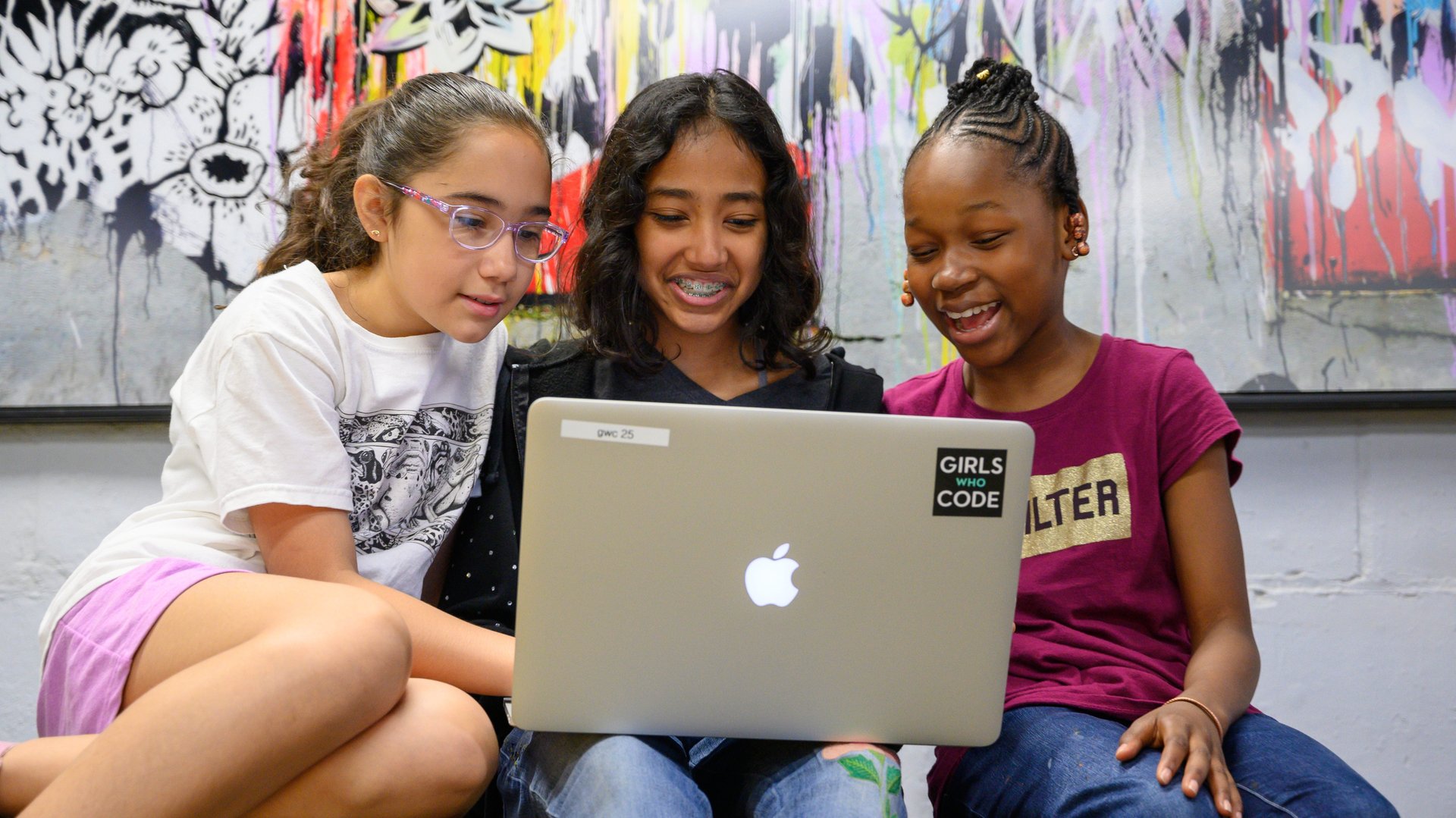Girls Who Code CEO Tarika Barrett on what causes tech’s gender gap
A reckoning for tech’s bro culture is long overdue, many believe.


A reckoning for tech’s bro culture is long overdue, many believe.
In November, Tesla, headed by the world’s richest man Elon Musk—who himself is often all sorts of inappropriate—was hit with a lawsuit over “nightmarish” sexual harassment on its Fremont factory floor. The company is silent on the allegations, but Musk has been busy making jokes about gimmicks that “blow the whistle on Tesla.”
Meanwhile, calls for game developer Activision Blizzard’s CEO Bobby Kotick to step down have intensified in the last month as evidence of years of sexual misconduct at the company comes to light.
On Nov. 18, educational non-profit organization Girls Who Code severed ties with Activision, a partner for its two-week summer coding programs for schoolgirls: “The news about Activision proves that our priorities are fundamentally misaligned. We cannot in good conscience continue to work with a company that is so antithetical to our own values.”
While it’s a bold stance, Girls Who Code continues to work with Tesla for the same program. Its long list of partners includes several other big tech firms who’ve faced allegations of gender discrimination and harassment, including Apple, Rockstar Games, Amazon, and WeWork.
Girls Who Code concluded that Activision crossed the line, but it also believes disengaging is not an ideal solution. Especially when it comes to trillion-dollar companies like Tesla, Apple, and Amazon, which collectively employ millions of people. Instead, the non-profit believes in having the tough conversations.

“We try to encourage companies to look deeply at their own practices and interrogate what they might be doing to alienate young people, and especially young women and people of color, or what they are doing to prevent them from being hired in the first place,” Tarika Barrett, CEO of Girls Who Code, told Quartz. “Every company is different and so there’s no blueprint for this type of process. But at the very least, we hope companies have discussions about work culture.”
Below are edited excerpts from Quartz’s interview with Barrett.
Why has tech’s frat bro culture become such a fixture of Silicon Valley?
Barrett: Culture is created by those empowered to be the loudest voice in the room. And the rooms in Silicon Valley tend to be very homogeneous, and representative of a very specific type of white, cis male. Whether the reasons are implicit or explicit, these are the type of people that hiring managers target for entry-level positions, and these are the people that rise the ranks in tech companies. We need to change who is in the room.
How does this culture put women at a disadvantage?
Barrett: The punishing work culture in tech, rooted in systemic racism and sexism, often alienates young women and women of color once they get their first job in the tech industry. Half of women in tech roles leave by the age of 35, many of them because they felt their workplace was inhospitable to women. Maybe these offices didn’t have adequate parental leave policies, or women weren’t represented in the ranks of leadership, or there was just a toxic corporate culture.
How can tech companies improve gender diversity?
Barrett: What we’re really asking is that people keep an open mind—redefining what they see as an appealing hiring candidate, and assessing promotion practices that keep women and women of color out of leadership positions.
One tangible and feasible change that all companies can make to shift this culture is to stop relying on the elitist system of academic credentialing in hiring, which offers a narrow and privileged perspective of success, shutting out historically marginalized students and failing to bring much needed diversity to tech companies. A focus on four-year university education, typically from Ivy League institutions, hurts our young people and the tech companies overall.
As we look ahead, we must think critically about altering how we support people in the workforce. Companies can begin to think about this is by offering child care, providing paid parental leave, offering flexible and asynchronous work hours, and increasing salaries of women so that they don’t have to make the choice between career and kids.
Why should tech companies take gender diversity seriously?
Barrett: On the most basic level, the usability of tech products is greatly hindered by a lack of female representation. One famous example is the first iteration of Apple’s health app, which didn’t even include any tracking on menstruation or fertility. This is a glaring omission. Imagine if there had been even one woman in the room making these decisions. What would that app have looked like?
When it comes to safety, we already know that the internet is less safe for women, for people of color, and for anyone who belongs to marginalized communities. Lately, it seems like any efforts to address harm on the internet, though appreciated, feels like too little, too late. With more female representation, Black and brown representation, and LGBTQIA representation in these top companies, things like hate speech, cyber-stalking, and revenge porn may have been taken more seriously, much sooner.
Tech as we experience it now is the result of the priorities of a privileged few, often sharing a singular perspective. The future of tech depends on a tech workforce that is representative of the diverse world we live in.
How important is female representation at the top?
Barrett: At Girls Who Code, we always say that you can’t be what you can’t see. Girls learn, in school and through culture, about men like Bill Gates and Mark Zuckerberg and Albert Einstein and Neil Armstrong—but not about the women pioneers in the field like Katherine Johnson and Ada Lovelace and Jean Bartik.
In their minds, a programmer is a boy in a hoodie alone in the basement or a man running a company in Silicon Valley. Before girls are 10 years old, they have already internalized these cultural touchstones. And these internalized beliefs resonate throughout their lives: in elementary school, in high school, in college, and in the workforce. Having more education and representation of women and people of color in tech can be the difference we need to empower a pipeline of girls to pursue the tech careers of the future.
We’ve come a long way in helping young girls see more women who look like me in the tech industry, but we need to see more women who look like me at the top of those tech industries so that young girls know a pathway exists for them.
How can women thrive in tech?
Barrett: We put too much of the burden to succeed in the workplace on marginalized people, and not enough pressure on the workplace to be more conducive to success. The reason behind the gender gap in tech is not the women themselves. If you’re a woman or someone from any underrepresented background in tech, and you managed to get into college, graduate with a technical degree, get noticed by hiring managers, and get hired, then I know you are already armed with the qualities and tools necessary to succeed in the workplace.
Instead, we need companies to prioritize pay equity, be mindful of how burnout tends to disproportionately impact women and adjust workloads, and create pathways for success and systems of support.
If we give women the opportunities and tools they need to develop their skills, if we give them access to mentors and role models who make them excited about a career in tech, if we make sure workplaces are welcoming and inclusive, if we agree that an unusually high tolerance for so-called locker room talk should not be a job requirement for women in tech… if we do these things, I guarantee we’ll start to see that gender gap close.
If there was one thing you could tell women thinking of giving up on their hard-earned careers in tech because of gender bias, what would it be?
Barrett: In recent years, and certainly it’s true at this very moment, the cultural conversation around the tech industry has been overwhelmingly one of harm. We are inundated with stories about major companies that are perpetuating the stark inequalities that exist in our country, for profit. The tech leaders we read about in the media are typically men– greedy and ego-driven, who are wasting valuable resources on their own whims instead of giving back to a struggling country.
These stories have created a binary: that you can either have a career in tech that makes you money, or you can have a career that you love and that helps your community. But that can’t be farther from the truth. I want women to know that they can do good in the world, and find joy, not in spite of their career in tech, but because of it. We want women to know: you can create a career in STEM on your own terms.